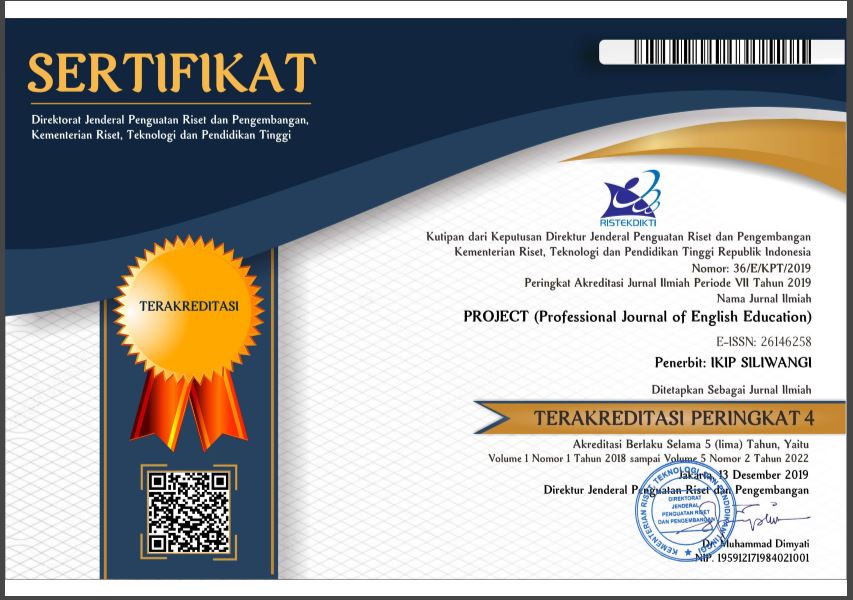ANALYZING THEMATIC STRUCTURE IN INDONESIAN FOLKTALES IN ENGLISH VERSION: A SYSTEMIC FUNCTIONAL GRAMMAR (SFG)
DOI:
https://doi.org/10.22460/project.v1i2.p85-94Abstract
This research is entitled “Analyzing Thematic Structure in Indonesian Folktales in English Version: A Systemic Functional Grammar Study (SFG)â€. The objectives of this study are analyzing and describing the themes, their elements and thematic progressions of Indonesian Folktales in English Version. The collected data, in this research, were taken from the book entitled “Indonesian Folktales†published in 1981 by Pustaka Media Publisher. One data, Princess Sumur Bandung which consists of 50 paragraphs and 221 clauses was chosen to be analyzed based on the theory of Systemic Functional Grammar (SFG) of Gerot and Wignell (1994). The method and technique used in this study are a descriptive qualitative method. The results of this research reveal that (1) there are two kinds of theme-rheme patterns are found; they are simple theme-rheme patterns and multiple theme-rheme patterns. In details, the simple theme-rheme patterns contain constant theme-rheme pattern, linear theme-theme rheme pattern, and derived theme-rheme pattern, while multiple ones contain a combination of constant and linear theme, a combination of linear and derived theme, and a combination of constant, linear and derived theme-rheme pattern. Besides, the combination of constant and linear theme-rheme pattern are the most frequently distributed. While the elements of themes which found are textual, interpersonal and ideational elements. Textual elements cover continuative, structural conjunction, wh-relative and conjunctive adjunct. Interpersonal elements cover modal adjunct, vocative, wh-interrogative and finite verbal operator. Ideational elements cover nominal group, noun, adverbial group, prepositional phrase, process, complement, group complex and adverb.
References
Anderson, M. and Anderson, K. 1997. Text Type in English 3. South Yarra:
Macmillan.
Bloor, T. & Bloor, M. 2004. The Functional Analysis of English (Second Edition).
USA: Oxford University Press.
Eggins, S. 1994. An Introduction to Systemic Functional Linguistics. London:
Pinter Publisher.
Eggins, S. 2004. An Introduction to Systemic Functional Linguistics 2nd Edition.
London: Continuum.
Gerot, L & Wignel, P. 1994. Making Sense of Functional Grammar. Sydney: Gerd
Stabler.
Halliday, M.A.K.1985. An Introduction to Functional Grammar. London: Edward
Arnold
Halliday, M.A.K.1994. An Introduction to Functional Grammar: Second Edition.
New York:Edward Arnold
Halliday, M.A.K. & Matthiessen, Christian M.I.M. 2004. An Introduction to
Functional Grammar, 3rd Edition, London, Arnold.
Knapp, P. and Waltikns, M. 2005. Genre, text, Grammar: Technologies For
teaching and Assessing Writing. Sydney: University of New South Wales Press.
Thompson, G. 2004. Introducing Functional Grammar 2nd Edition. London:
Arnold.




